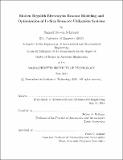| dc.contributor.advisor | Jeffrey A. Hoffman. | en_US |
| dc.contributor.author | Schreiner, Samuel Steven | en_US |
| dc.contributor.other | Massachusetts Institute of Technology. Department of Aeronautics and Astronautics. | en_US |
| dc.date.accessioned | 2015-09-17T17:44:44Z | |
| dc.date.available | 2015-09-17T17:44:44Z | |
| dc.date.copyright | 2015 | en_US |
| dc.date.issued | 2015 | en_US |
| dc.identifier.uri | http://hdl.handle.net/1721.1/98589 | |
| dc.description | Thesis: S.M., Massachusetts Institute of Technology, Department of Aeronautics and Astronautics, 2015. | en_US |
| dc.description | This electronic version was submitted by the student author. The certified thesis is available in the Institute Archives and Special Collections. | en_US |
| dc.description | Cataloged from student-submitted PDF version of thesis. | en_US |
| dc.description | Includes bibliographical references (pages 161-170). | en_US |
| dc.description.abstract | In-Situ Resource Utilization (ISRU), the practice of leveraging space resources to support space exploration, has long been considered as a possible avenue for reducing the mass and cost of exploration architectures. In particular, producing oxygen from lunar regolith holds great promise for maintaining life support systems and enabling orbital refueling of chemical propulsion systems to reduce launch vehicle mass. Unfortunately, significant uncertainty as to the mass, power, and performance of such ISRU systems has prohibited a rigorous quantitative analysis. To this end, parametric sizing models of several ISRU systems are developed to better understand their mass, power, and performance. Special focus is given to an oxygen production technique, called Molten Regolith Electrolysis (MRE), in which molten lunar regolith is directly electrolyzed to produce oxygen gas and metals, such as iron and silicon. The MRE reactor model has a foundation of regolith material property models validated by data from Apollo samples and regolith simulants. A coupled electrochemical and thermodynamic simulation is used to provide high-fidelity analysis of MRE reactor designs. A novel design methodology is developed that uses data from the simulation to parametrically generate mass, volume, power, and performance estimates for an MRE reactor that meets a set of performance criteria. An integrated ISRU system model, including an MRE reactor, power system, excavator, liquid oxygen storage system, and other systems, is leveraged in a hybrid optimization scheme to study the optimal system design and performance characteristics. The optimized models predict that a 400 kg, 14 kW MRE-based ISRU system can produce 1,000 kg oxygen per year from lunar Highlands regolith. A 1593 kg, 56.5 kW system can produce 10,000 kg oxygen per year. It is found that the optimal design of an MRE-based ISRU system does not vary significantly with regolith type, demonstrating the technique's robustness to variations in regolith composition. The mass and power of the optimized ISRU system exhibit an economy of scale, indicating that larger quantities of oxygen can be produced more efficiently. In fact, the production efficiency estimates of a lunar ISRU system provide initial evidence that lunar ISRU may prove beneficial in supporting a Mars Exploration campaign. | en_US |
| dc.description.statementofresponsibility | by Samuel Steven Schreiner. | en_US |
| dc.format.extent | 170 pages | en_US |
| dc.language.iso | eng | en_US |
| dc.publisher | Massachusetts Institute of Technology | en_US |
| dc.rights | M.I.T. theses are protected by copyright. They may be viewed from this source for any purpose, but reproduction or distribution in any format is prohibited without written permission. See provided URL for inquiries about permission. | en_US |
| dc.rights.uri | http://dspace.mit.edu/handle/1721.1/7582 | en_US |
| dc.subject | Aeronautics and Astronautics. | en_US |
| dc.title | Molten Regolith Electrolysis reactor modeling and optimization of in-situ resource utilization systems | en_US |
| dc.type | Thesis | en_US |
| dc.description.degree | S.M. | en_US |
| dc.contributor.department | Massachusetts Institute of Technology. Department of Aeronautics and Astronautics | |
| dc.identifier.oclc | 921147148 | en_US |
